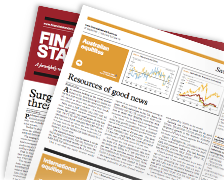Investment Performance Review Ratings (IPRs) The Financial Standard Intelligence Unit's Investment Performance Review Ratings (IPRs) are an unbiased quantitative assessment of investment funds using their historical risk-adjusted performance and other key metrics. The objective of the Investment Performance Review ratings is to provide a quantitative ranking of actively managed investment funds to allow investors to evaluate investment funds on a risk-adjusted basis free from research biases and analysts' subjective preferences. When evaluating performance, it is of course not enough to look at raw returns. It is crucially important to consider the risk(s) associated with these particular returns. The Financial Standard Intelligence Unit recognises that different investors have different requirements. Hence in evaluating investment performance, the IPR ratings have three distinct elements that are synthesized to derive the composite Investment Performance Review Rating. These elements are evaluated by calculating three different reward-to-risk ratios and then placing each fund into quartiles for each of the ratios analysed. Funds are then assigned a letter to signify their quartile position where A represents top quartile ranking, B represents 2nd quartile, C represents 3rd quartile and D represents the 4th quartile. Each letter is based on a particular performance metric or ratio which, in turn, is relevant to a particular investment requirement. The composite rating is the combination of each of the three elements. Reflecting this rationale, a fund that is rated AAA is best of breed fund across the three different investment requirements. The specific ratios are explained in detail in section 6. The table below describes each ratings element and its intended purpose.
Sharpe Ratio Sharpe Ratio = Average Excess Return / SD of Excess Returns An investor obviously wants to maximise return, while at the same time minimising risk. The Sharpe ratio measures the relationship between the excess return of the fund and the risks the fund took to achieve that return. The higher the Sharpe Ratio, the more return achieved per unit of risk. Funds that achieve high Sharpe Ratios are therefore more efficient in their use of risk than funds that achieve low Sharpe Ratios. Treynor Ratio Treynor Ratio = Average Excess Return / Beta of Fund Market risk is represented by Beta, where Beta measures the relationship between the volatility in the fund's monthly returns compared to the volatility in the monthly returns of the market benchmark. A high Beta can be interpreted as a fund that is more volatile than the market, while a low Beta means the fund is less volatile than the market. Reflecting this, Beta can also be viewed as a measure of the fund's sensitivity of returns to the market's returns. An investor wishing to compare different funds within the same asset class classification category should compare the Treynor Ratios as funds with higher Treynor Ratios are more efficient at converting market risk into excess return and so are more desirable for inclusion in investment portfolios. And because funds with high Treynor Ratios are delivering excess returns for lower amounts of market volatility, this means that funds with high Treynor Ratios can be grouped into portfolios while still maintaining lower overall risk levels. Appraisal Ratio Appraisal Ratio = Alpha of the Fund / Stock Selection Risk In order to add value, managers take risk by deviating from the index. They may hold fewer stocks or bonds, and they may weight them differently than their index weights. This ratio can also be referred to as the Information Ratio because it focuses on the risk and return generated from the fund manager's ability to use information to deviate from the index. The Appraisal Ratio measures how efficient the fund manager is in converting their securities selection risk into excess return. Reflecting this, a high Appraisal Ratio means the fund manager is successfully using their securities selection risk to achieve excess returns. A high Appraisal Ratio means that the fund manager would be ideally suited to complementing a passive or indexed fund manager. Why are Investment Performance Review ratings based on purely quantitative processes? A quantitative process is one based on objective analysis incorporating scientifically based calculations using historical data. A qualitative process is one based on human experience, judgment and intuition and typically involves collecting heuristic data through personal interviews and other judgment based procedures. The main distinction between the two approaches is that qualitative ratings assessments are prone to subjective judgments while quantitative rating assessments are objective. This means the IPR ratings are capable of standing alone as an investment fund ratings regimen. However, the Financial Standard Intelligence Unit recognises that some fund managers and advisers have preferences for subjective investment fund assessments and so the Investment Performance Review ratings have been deliberately designed and structured to complement these qualitative ratings processes. Calculating the IPR component ratios The IPR component ratios are calculated using performance data for the most recent three-year period. This fund performance data is sourced directly from fund managers via Rainmaker's comprehensive performance surveys which analyse almost 600 wholesale managed funds each month. In order for the funds to be truly comparable, funds are carefully assigned into their appropriate classification category. This is because funds in different investment categories can have significantly different risk and return characteristics. As an illustration of how this process operates, Australian equities comprehensive funds (eg diversified Australian equity funds) are benchmarked to either the S&P/ASX300 and so are not compared to sector specialist funds such as small cap or technology funds. IPR ratings are updated monthly published in each print edition of the Financial Standard and are also on this website. Asset class structure of the IPR ratings The asset classes used to categorise investment products are:
How can the Investment Performance Review Ratings be used to aid investment decision-making? All industry professionals involved in appointing investment managers - managers of multi-manager portfolios, super fund trustees, investment committee members or financial advisers - can use the richness of the information in the Investment Performance Review Ratings. Suppose you need to choose only one active fund for Australian equities. The appropriate measure to consider is the Sharpe ratio. That means only the first letter or element of the composite rating is directly relevant. Let's now assume you are comparing two active funds. The first fund has an Investment Performance Review rating of BAA and the second fund has a rating of ABB. In this case the second fund is superior on a risk-adjusted returns basis, since the first letter A means the fund is in the top quartile compared to the first fund, which is in the second quartile. An investor interested in blending two or more active managers together needs to be able to compare performance across different active managers. Since different managers can have different levels of exposure to the market, it is necessary to employ a relative risk measure. In this case the appropriate reward-to-risk measure is the Treynor ratio, which uses a relative risk (relative to the market portfolio or benchmark) measure. An investor wishing to combine an active manager with a passively managed core portfolio needs to evaluate the stock-picking or security selection ability of different active managers. The ratio that measures this ability on a risk-adjusted basis is the appraisal ratio. Reflecting this, the Financial Standard Investment Performance Review Ratings can be used to aid decision-making regarding:
The IPR ratings can also be used by investment, dealer group and super fund professionals as a diagnostic tool to help understand and monitor the quality of fund managers used in:
Reflecting this, the IPR ratings are already used successfully by Rainmaker within its SelectingSuper ratings of superannuation funds and master trusts. Importantly, the Financial Standard Intelligence Unit is available to provide assistance in these diagnoses and has a range of support services ready assist fund managers, super funds, dealer groups, financial advisers and platform mangers in this regard. More information For additional information, please contact: Andrew Keevers |
Editor's Choice
Actuaries Institute proposes new performance test measure
JANA appoints new director of client development
MSC Certane wins Suncorp mandate
Auditors lambast mandatory climate reporting requirements

Where do advisers invest their time?


Quality and Yield. A Powerful combination.


Why it could be a good time to be a growth contrarian

Products
Featured Profile

Fiona Mann
BRIGHTER SUPER
























